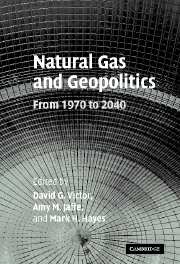Book contents
- Frontmatter
- Contents
- List of figures
- List of tables
- List of boxes
- List of contributors
- Foreword by James A. Baker, III
- Acknowledgments
- List of acronyms and abbreviations
- Part I Introduction and context
- Part II Historical case studies
- Part III International gas trade economics
- 11 The Baker Institute World Gas Trade Model
- 12 Political and economic influences on the future world market for natural gas
- 13 Market structure in the new gas economy: is cartelization possible?
- Part IV Implications
- Appendix: Technical notes
- Index
- References
11 - The Baker Institute World Gas Trade Model
Published online by Cambridge University Press: 22 September 2009
- Frontmatter
- Contents
- List of figures
- List of tables
- List of boxes
- List of contributors
- Foreword by James A. Baker, III
- Acknowledgments
- List of acronyms and abbreviations
- Part I Introduction and context
- Part II Historical case studies
- Part III International gas trade economics
- 11 The Baker Institute World Gas Trade Model
- 12 Political and economic influences on the future world market for natural gas
- 13 Market structure in the new gas economy: is cartelization possible?
- Part IV Implications
- Appendix: Technical notes
- Index
- References
Summary
Introduction
Natural gas increased from roughly 19 percent of world primary energy demand in 1980 to about 23 percent in 2002 (EIA 2004) and is now produced and consumed in forty-three countries around the world. Moreover, the International Energy Agency (IEA) (IEA 2004) predicts that world natural gas demand will be about 90 percent higher by 2030. It also projects that the share of gas in world primary energy demand will increase from 23 percent in 2002 to 25 percent in 2030, with gas potentially overtaking coal as the world's second largest energy source. The IEA predicts that the power sector will account for 60 percent of the increase in gas demand.
Much of current world production of natural gas comes from mature basins in the United States and the North Sea. Russia, where production rivals that in the United States, currently accounts for almost one-quarter of world production but, unlike the United States, has substantial reserves that remain untapped. Furthermore, Russia and the countries of the Former Soviet Union (FSU) rank first globally in undiscovered natural gas potential (USGS 2000). These countries already export considerable quantities of natural gas to Europe, and they are expected to become important suppliers to the growing needs in Asia.
The countries of the Middle East also have substantial natural gas resources, both proved and potential, which are relatively untapped.
- Type
- Chapter
- Information
- Natural Gas and GeopoliticsFrom 1970 to 2040, pp. 357 - 406Publisher: Cambridge University PressPrint publication year: 2006
References
- 19
- Cited by



